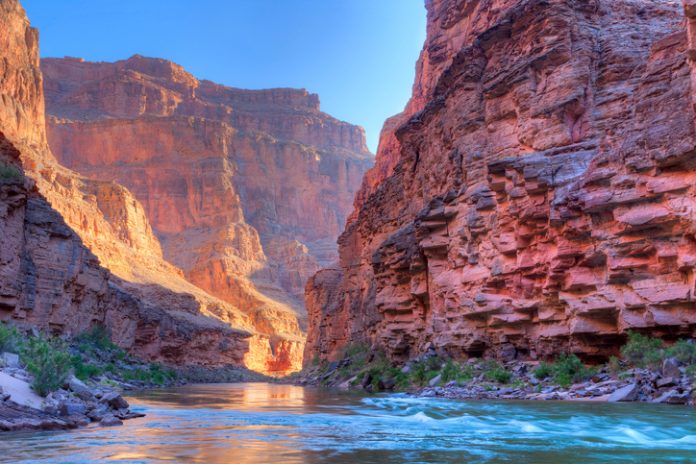Water shortages in Western states have placed a shadow over the 100-year anniversary of the 1922 Colorado River Compact (CRC), a seven-state agreement signed in 1922 delineating and setting apportioning rules for water from the Colorado River that was instrumental in the growth of cities such as Denver, Las Vegas, Los Angeles, Phoenix, and San Diego.
Arizona’s Glen Canyon Dam, along with its reservoir Lake Powell, and Nevada’s Hoover Dam and its reservoir, Lake Mead, were the direct result of the signing of the compact. However, due to drought and significantly increased population and development leading to a massive increase in water use in the Southwest, those reservoirs are getting dangerously close to “dead pool” levels, which means the dams cannot release water downstream.
Demand Threatens ‘Dead Pool’
Lake Mead is currently 1,046 feet of surface elevation above sea level in late October, only 151 feet above its dead pool level and 96 feet above its minimum power pool elevation, or the level where the reservoir can no longer generate hydroelectricity.
Lake Powell is also currently about 160 feet above its dead pool level and just 39 feet above its minimum power pool elevation.
The CRC divided the river’s water equally between an Upper Basin of Colorado, New Mexico, Utah, and Wyoming, and a Lower Basin of Arizona, California, and Nevada, with the dividing line between the two basins being just south of the Lake Powell reservoir. The Upper Basin provides the Lower Basin with a certain amount of water each year, which is controlled and measured by the Glen Canyon Dam and Lake Powell.
California Uses Most Water
In 1948, California convinced Congress to allocate this water by population, giving the Golden State control of nearly 59 percent of the Lower Basin’s allocation.
California currently has a population 78 percent greater than the other six states in the compact combined. It routinely uses all of its allocated share along with portions of the other compact states’ unused shares and routinely fights other states’ attempts to develop the water supply to which they are entitled.
This has led to bitter struggles between the compact states regarding apportionment during the drought, as well as with the federal government. The Bureau of Land Management, in effective, ordered the compact states to cut their water use between 2 and 4 million acre-feet a year.
To be fair, California should develop other water resources, says Greg Walcher, president of the Natural Resources Group.
“All the other states need to insist that California reduce its use of the Colorado River, at least to its entitled share,” said Walcher. “Californians have multiple options, including new storage, conservation, and especially desalination.
“All three are included in their official water plan, but the California Coastal Commission recently voted down—unanimously—a desalination proposal that had been in the works for decades,” said Walcher. “That makes it difficult for the other states to be sympathetic, even in drought years, when we see California unwilling to consider the advantage it has always had over all the others: 840 miles of coastline on the largest body of water on Earth.”
Desalination Technology Used Worldwide
Desalination is used around the world to provide water for agriculture and drinking water in arid regions, says Walcher.
“The technology is proven at 18,000 desalination plants all over the world, so California needs to get serious about solving its water shortage, and stop looking at Lake Powell as its free supply, a supply that is clearly insufficient to that demand,” Walcher said. “California has no shortage of water, only of political will.
Developing desalination is only a step in a sound water supply plan for California, says K. Lloyd Billingsley, a policy fellow with California’s Independent Institute.
“More desalination plants would boost supply but would not end California’s water woes,” wrote Billingsley, in a policy paper in 2016. “Those trace back to the federal Bureau of Land Management, the largest water wholesaler in the Western United States.
“The BLM generally makes more water available to farmers than to other users and underprices it to everyone … [because] the agency has no incentive to allocate water to its highest-valued, best use, and that is also true of California’s water districts,” wrote Billingsley. “In times of scarcity or abundance, the best solution is to replace California’s bureaucratic allocation system with market pricing, and to empower water users to engage in mutually beneficial trades.”
Tim Benson (tbenson@heartland.org) is a senior policy analyst at The Heartland Institute.
For more on California water problems, click here.
For more on the Colorado river, click here.


























